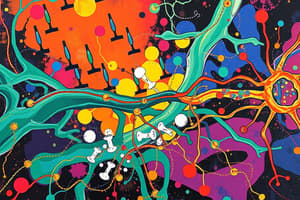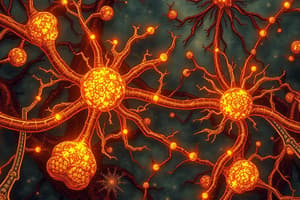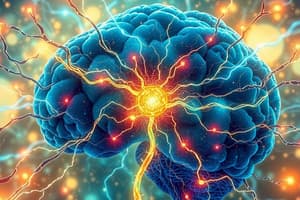Podcast
Questions and Answers
Which method involves using antibodies to identify the location of specific proteins within cells?
Which method involves using antibodies to identify the location of specific proteins within cells?
- In situ hybridization
- Microelectrode
- Microiontophoresis
- Immunocytochemistry (correct)
If a researcher applies a substance to a cell and assesses the postsynaptic actions, which method are they most likely using?
If a researcher applies a substance to a cell and assesses the postsynaptic actions, which method are they most likely using?
- In situ hybridization
- Ligand-binding assay
- Immunocytochemistry
- Microiontophoresis (correct)
Which of the following neurotransmitters is synthesized from tryptophan?
Which of the following neurotransmitters is synthesized from tryptophan?
- Dopamine
- Acetylcholine
- Norepinephrine
- Serotonin (correct)
Which of the following describes the role of choline acetyltransferase (ChAT)?
Which of the following describes the role of choline acetyltransferase (ChAT)?
Which of the following is the correct order of events in G-protein operation?
Which of the following is the correct order of events in G-protein operation?
If a drug increases cAMP production and postsynaptic activity, which neurotransmitter system is most likely affected?
If a drug increases cAMP production and postsynaptic activity, which neurotransmitter system is most likely affected?
Which of the listed criteria is required to classify a substance as a neurotransmitter?
Which of the listed criteria is required to classify a substance as a neurotransmitter?
A drug that blocks the breakdown of a neurotransmitter in the synapse would lead to which of the following?
A drug that blocks the breakdown of a neurotransmitter in the synapse would lead to which of the following?
What is a key characteristic of NMDA channels?
What is a key characteristic of NMDA channels?
What is a primary mechanism by which cocaine exerts its effects on the brain?
What is a primary mechanism by which cocaine exerts its effects on the brain?
Flashcards
Neurotransmitters
Neurotransmitters
Chemicals that transmit signals across a synapse, affecting target neurons, muscles, or glands.
Acetylcholine (ACh)
Acetylcholine (ACh)
A neurotransmitter synthesized from choline, important at neuromuscular junctions; Loewi identified it first.
Immunocytochemistry (IHC)
Immunocytochemistry (IHC)
The process of using antibodies to locate transmitters and synthesizing enzymes within cells.
In situ hybridization
In situ hybridization
Signup and view all the flashcards
Microiontophoresis
Microiontophoresis
Signup and view all the flashcards
Neuropharmacological analysis
Neuropharmacological analysis
Signup and view all the flashcards
Nicotinic Receptor
Nicotinic Receptor
Signup and view all the flashcards
Muscarinic Receptor
Muscarinic Receptor
Signup and view all the flashcards
Glutamate
Glutamate
Signup and view all the flashcards
GABA
GABA
Signup and view all the flashcards
Study Notes
Neurotransmitters
- Many different types exist including amino acids, amines, peptides, gases, and opioids
- Synthesized and degraded by enzymes
- Some neurons can use more than one, known as co-transmission
- Affect targets: neurons, muscles, and glands
- Commonly interacting with receptors
- Agonist vs. antagonist
Synaptic Transmitters and Families of Transmitters
- Amines include Quaternary amines with Acetylcholine (ACh)
- Monoamines are further divided into Catecholamines, with Norepinephrine(NE), Epinephrine(adrenaline), and Dopamine (DA)
- Also, Indoleamines, with Serotonin(5-hydroxytryptamine;5-HT), and Melatonin
- Amino Acids include Gamma-aminobutyric acid (GABA), Glutamate, Glycine, and Histamine
- Neuropeptides include Opioid peptides: Enkephalins(Met-enkephalin and Leu-enkephalin), Endorphins(ß-endorphin), and Dynorphins(Dynorphin A)
- Peptide Hormones include Oxytocin, Substance P, Cholecystokinin (CCK), Vasopressin, Neuropeptide Y (NPY), and Hypothalamic releasing hormones
- Gases include Nitric oxide and Carbon monoxide
Neurotransmitter Synthesis
- Choline, found in milk, eggs, and nuts, is used for ACh
- Tryptophan, in soy, is a precursor for 5-HT
- Phenylalanine, from protein-rich foods like meat, fish, cottage cheese, and nuts, is needed to make DA, NE, and EP
Neurotransmitter Systems
- Neurotransmitter systems are defined by their chemical molecule, synthetic machinery, packaging, reuptake and degradation and action
- Acetylcholine(ACh) was first identified by Loewi
- Nomenclature is based on -ergic
- Dale discovered Cholinergic and noradrenergic neurotransmitters
- Loewi and Dale shared the 1936 Nobel Prize in physiology or medicine
Criteria for identifying Neurotransmitters
- Synthesis and storage must occur in the presynaptic neuron
- Must be released by the presynaptic axon terminal
- When applied, it must mimic the postsynaptic cell response produced by the release of neurotransmitter from the presynaptic neuron
- Receptors must exist
- Must have an inactivation mechanism
- Activity varies based on developmental stage, daily variations and drug variations
Studying Neurotransmitter Systems
- Immunocytochemistry (IHC) is used for localizing transmitters and transmitter-synthesizing enzymes to cells, using antibodies to show protein locations
- In situ hybridization localizes the synthesis of protein or peptide to a cell by detecting mRNA sequence and creating a probe
- Shows which neurons produce which mRNA transcripts
Studying Transmitter Release
- Used to confirm if a transmitter candidate is synthesized and localized in the terminal, and whether it's released upon stimulation
- Brain slice acts as a model
- Kept alive in vitro to stimulate synapses, and collect and measure released chemicals
- Like Loewi, but often difficult
- Molecules may seem a neurotransmitter
- Microiontophoresis: assesses postsynaptic actions by applying substances to cells in small amounts
- Microelectrode: probe used in measuring effects on membrane potential
Studying Receptor Subtypes
- Methods to study Receptor Subtypes include Neuropharmacological analysis
- Agonists and antagonists are used such as Nicotine/Curare agonists and antagonists for ACh receptors
- ACh receptors are Nicotinic and muscarinic
- Glutamate receptors include agonists such as: AMPA, NMDA, and kainate
Acetylcholine(ACh)
- First neurotransmitter discovered by Otto Loewi
- Found at NMJs
- Linked to Black widow venom, Botulin, Botox, Nerve gasses and insecticides, and Alzheimer's Disease
- ChAT makes ACh in terminal, packaged by ACh transporters
- Degraded in cleft by acetylcholinesterase (AChE)
ACh Receptors
- Nicotinic receptors are found at NMJs, are ionotropic and usually excitatory, and Curare is an antagonist
- Muscarinic receptors affect the Heart, are Metabotropic, can be Excitatory or inhibitory, and Atropine is an antagonist
Study of Receptors
- Use ligand-binding methods
- Identifies natural receptors using radioactive ligands
- Ligands used can be agonists, antagonists, or chemical neurotransmitters
- Opiate receptors are an example of receptors which were discovered before the endogenous chemical that binds to them
- Naloxone antagonist
Receptor Subunit Properties
- Molecular analysis is used to determine receptor protein classes
- Different polypeptides can make up subunits
- Transmitter-gated ion channels
- Nicotinic receptors and GABAA receptors are examples
Other Amine Neurotransmitters: Catecholamines
- Catecholamines are involved in movement, mood, attention, and visceral function
- Tyrosine is the precursor amino acid, found in high-protein foods
- Dopamine is a major wanting NT
- ~1 million neurons
- Receptors: D1, D2, D3, D4, D5
- Norepinephrine(noradrenaline)
- Metabotropic: B1, B2
- Epinephrine(adrenaline)
- Metabotropic: A1, A2
- The reuptake from the cleft by Na+-dependent transporters
- Reloaded or degraded by MAO
Serotonergic (5-HT) Neurons
- Serotonergic Neurons are amine neurotransmitters
- Only ~200,000 neurons
- Cell bodies concentrated in brainstem/raphe nuclei
- Linked to Sleep states, depression, OCD, and eating
- Selective serotonin reuptake inhibitors (SSRIs)—antidepressants
- Hallucinogens (e.g. MDMA, LSD)
- 15 receptor subtypes with different types
- 5HT1..
- MAO or reloaded
- 2-step synthesis of serotonin derives from tryptophan
Amino Acids as Neurotransmitters
- Differences among amino acidergic neurons are quantitative, not qualitative
- Terminated by reuptake into terminals and astrocytes
- Glutamate is a major excitatory neurotransmitter
- Glutamate can cause a glutamate cascade/excitotoxicity
- Astrocytes clear cleft
- Ionotropic receptors
- AMPA, kainate, NMDA (learning & memory)
- Metabotropic
- mGluR
- GABA is present in 40-50% of inhibitory synapses
- Receptors = GABAA, В, С
- Keeps brain from excessive arousal(anxiety, insomnia)
- Agonists = tranquilizers
Amino Acid-Gated Channels
- Features Glutamate-gated channels such as AMPA, NMDA, and kainite
- NMDA channels are both voltage and ligand-dependent
- Important for learning and long-term potentiation
- GABA receptors have multiple binding sites
- Binding sites for GABA, ethanol, benzodiazepines, and barbiturates
- Cl- channel
- Never mix alcohol & benzodiazepines
Other Neurotransmitter Candidates and Intercellular Messengers
- ATP excites some neurons and is often a co-transmitter. Degraded to make adenosine and binds to purinergic receptors
- Endocannabinoids are retrograde messengers
- presynaptic CB receptors
- Nitric Oxide is a retrograde messenger
- Viagra increases NO's ability to relax vessels
Transmitter-Gated Channels
- Fast synaptic transmission
- Sensitive detectors of chemicals and voltage
- Regulate flow of large currents
- Differentiate between similar ions
- 4-6 protein subunits form a pore
- Examples
- nicotinic ACh receptor at NMJ
- GABAA receptor
- NMDA receptor for Glutamate
G-Protein-Coupled Receptors and Effectors:Transmissions
- Three steps in transmission:
- Binding of the neurotransmitter to the receptor protein
- Activation of G-proteins
- Activation of effector systems can either stimulate or inhibit effectors
- Signal is passed from receptor to effector proteins
- Basic structure of G-protein-coupled receptors (GPCRs)
- Single polypeptide with several alpha helices
Five Steps in G-Protein Operation
- Inactive: 3 subunits-α, β, and γ-"float" in membrane (a bound to GDP)
- Active: bumps into activated receptor and exchanges GDP for GTP
- Ga-GTP and GBY-influence effector proteins
- Ga inactivates by slowly converting GTP to GDP
- Ga and Gẞy recombine to start the cycle again
G-Protein-Coupled Effector Systems
- The shortcut pathway is a direct, fast, and localized route from receptor to G-protein to ion channel
- Second messenger cascades involves G-protein coupling neurotransmitter with downstream enzyme activation
- Some cascades branch
- Phosphate groups are added to or removed from a protein, which changes the conformation and biological activity
- Signals can be amplified, longer-lasting and more varied than in ligand-gated receptors
Summation and Concluding Remarks
- Neurotransmitters transmit information
- They are an essential link between neurons and effector cells
- One transmitter activates more than one receptor subtype for a greater postsynaptic response (divergence)
- Different transmitters converge to affect same effector system (convergence)
- Signaling pathways are inputs which vary temporally and spatially and drugs can shift the balance of signaling power
Psychopharmacology
- Is a branch of pharmacology and the study of Psychological effects of drugs
- Pharmakon means Charm, poison, scapegoat, remedy/medicine
- Virtually all ingested substances can alter bodily functions
- A drug is a chemical administered to bring about desired change with pronounced effects in small quantities
- Drugs are exogenous ligands
Drugs and Mechanisms
- No drug has a single effect
- Higher concentrations interact with variety of molecules
- Few bind to a single target
- Drugs do not 'seek' targets
- Drugs work by one or more of the following mechanisms
- Increasing neurotransmitter synthesis
- Causing vesicles to leak
- Increasing neurotransmitter release
- Decreasing reuptake, thus increasing the time the NT is in the synapse
- Blocking the breakdown of the neurotransmitter, thus increasing the concentration
- Directly stimulating or blocking postsynaptic receptors
Drug Types
- Opiates is an umbrella term of drugs, including natural, synthetic and semi-synthetics
- Cocaine is a powerfully addictive stimulant drug
- Alter neural messaging and functionality
Opiates
- Includes Painkillers, narcotics, Heroin(artificially modified form, 3 x morphine), Fentanyl, OxyContin, and Percocet
- Opiates bind to receptors in limbic, hypothalamus, locus coeruleus, and in periaqueductual gray
- They are G-protein coupled receptors that are responsible for the strong potential for addiction/severe withdrawal, and overdose(respiratory depression)
Cocaine
- Originates from the Coca plant and traditionally consumed in chew leaves
- In chew form, provides endurance, hunger alleviation, and well-being
- A Cocaine powder, crack, is purified form addictive
- Blocks monoamine transporters for NE and DA (particularly in nucleus accumbens)
- Increases cAMP production and postsynaptic activity
Reward Circuitry
- Reward Pathway features the ventral tegmental area to nucleus accumbens and connects to the prefrontal cortex
Consequences of Drug Use
- A Drug Tolerance, or habituation, is a process where more drugs are required to achieve a certain response
- Withdrawal occurs when the body does not have a drug present
- Craving is a strong urge to do drugs
- Addiction is a state that involves Craving, seeking, and use (psychological & behavioral)
Drug Vulnerabilities
- People differ in their vulnerability to drug use
- Biological factors (brain organization, receptor distribution)
- Personal characteristics
- Family situation
- Environmental factors
- Prenatal environment
- Prevent use, abuse and dependence
- No single approach is uniformly effective
Studying That Suits You
Use AI to generate personalized quizzes and flashcards to suit your learning preferences.




